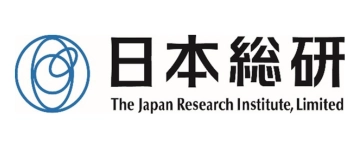The JRI Future Vol. 1: Taking the Next Generation as the Starting Point
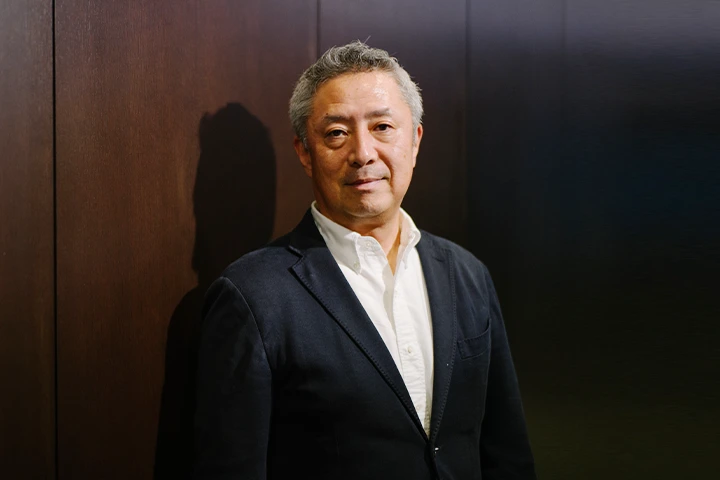
As an SMBC Group member, the Japan Research Institute (JRI) delivers integrated knowledge engineering services that draw on its three main functions: think tank operation, consulting, and IT solutions. Guided by JRI’s recently coined purpose statement "Realizing the Preferred Future. Moving Toward the Next Generation. Creating new value together by linking diverse individuals through active listening and dialog," the think tank and consulting divisions are taking various initiatives aimed at realizing a “convivial society” with the help of digital transformation technologies.
We asked JRI Senior Managing Director Teruhiko Kinoshita to tell us more about JRI’s vision for the future and what specific steps JRI is taking to realize this.
A society where everybody can play active roles with confidence and motivation
You’re aiming to “create the future from the perspective of next generations.” Why?
“Lackluster” would be a great way of describing Japanese society and Japanese companies at this point in time. But why? We put it down to change in the pattern of success.
Up until the bubble years, Japan enjoyed a demographic dividend* whereby the input of labor hours particularly in assembly-based manufacturing saw sales continue to expand. Now that both our demography and our focal industries have changed, that approach is no longer valid, but so many initiatives are still seeking to recreate that past pattern of success.
If we continue to cling to the past, the society we pass on to our children and grandchildren will not be a happy one. Rather than thinking about our own present happiness, we should be focused on creating a society that encourages confidence and motivation in the next generations. That’s what we mean by creating a future from the perspective of next generations.
When it comes to our services too, we can’t hope to invigorate Japanese society and the Japanese corporate world if we only set out to resolve corporate and local government issues on a six-month or annual turnaround basis. We’re strongly aware of the need to take a longer-term perspective and widen our gaze to Japan as a whole, tackling all stages of the process from strategy design to implementation.
* A phenomenon whereby the economic growth rate is boosted not only by the greater productivity enabled by factors such as technological advance, but also the larger working-age population realized through population growth.
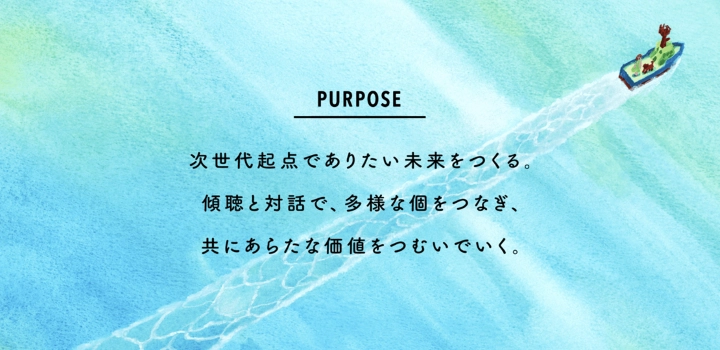
A “convivial society” where each sector provides and receives services on a mutual basis
You are advocating a “convivial society” as one ideal future. Could you break this down for us?
In a convivial society, people can experience the joy of living and achieve a deep sense of human fulfillment, because all the stakeholders—individuals, private enterprise, local government, central government, research institutes, and financial institutions, etc.—act as autonomous entities, cooperate with each other, and interact for a better future.
Until now, individuals have been consumers receiving goods and services created by corporations and governments which pursue economic expansion. Our aim is to create a society in which central and local governments, private enterprise, and individuals all provide and receive services and everyone can contribute proactively to society.
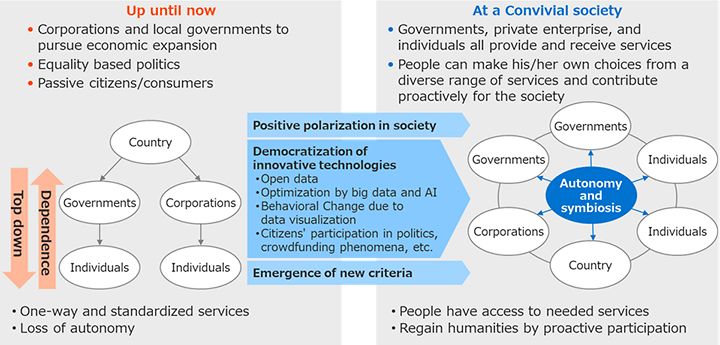
This convivial society draws on the concept of conviviality as envisaged by the Vienna-born thinker Ivan Illich. Basically, Illich’s idea was to enable individuals to maximize the expression of their innate individuality and capabilities through their relationships with others and with nature. This concept of conviviality has long been translated into Japanese as "independence and coexistence," but we believe what Illich really meant was "autonomy and symbiosis," so we took that translation.
In modern society, the technologies and systems which we create as means to an end often become ends in themselves. For example, schools were originally places where, through discussion with a whole spectrum of people and sharing of experts’ findings, we acquired the knowledge and mental approaches needed for life. Somewhere along the line, however, the goal instead became going to “better” schools and universities.
Ideally, individuals should think about the end to which they want to put a particular means and make the best choice for themselves. Illich regards this as autonomy. We are strongly aware that we want our children as the bearers of the next generation to be able to have options and to acquire the ability to live self-reliantly.
In addition, coexistence implies making up for each other’s shortcomings, whereas symbiosis means stimulating and inspiring each other to grow. Our ideal is that the process of mutual stimulation and inspiration will lead members of society to all live better lives together. That's why we lean more toward the idea of symbiosis.
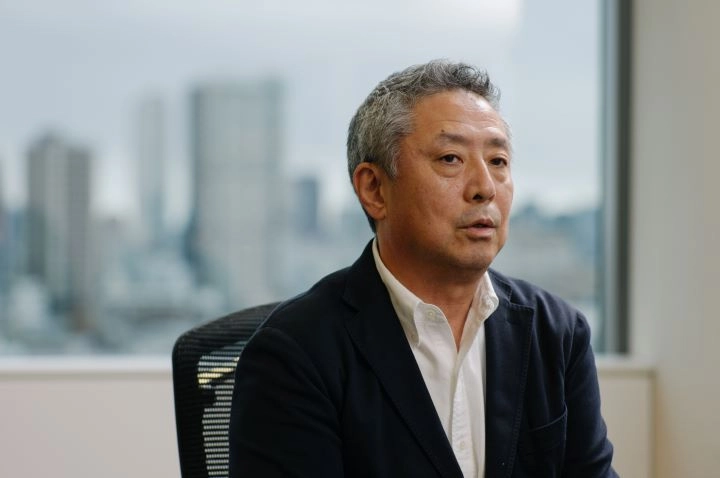
Digitally-driven projects aimed at realizing the ideal future
What specifically are you doing to realize your convivial society?
Well, we have identified six main themes—environment and energy; transport; education; health, medical care, and nursing care; food, agriculture, and food security; and symbiotic growth—and we are pursuing multiple projects in relation to each.
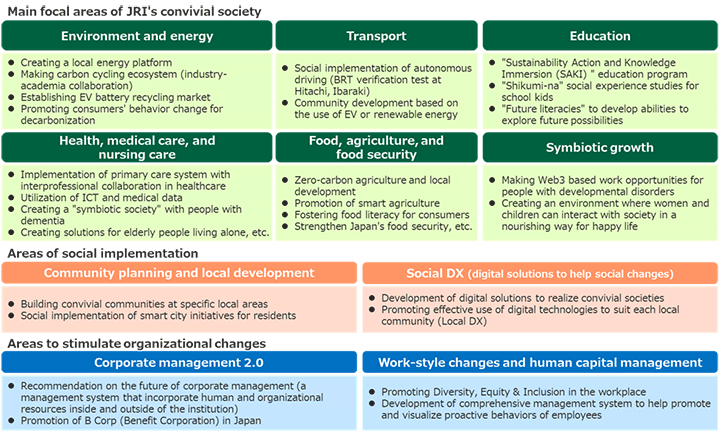
For example, in relation to the environment and energy, we are developing a mechanism for local production and consumption of energy in Hokkaido’s Ishikari City so that renewable energy generated in Ishikari is also consumed there. We also plan to enable any excess energy that can’t be consumed in Ishikari to be utilized in surrounding areas via large storage batteries and hydrogen production.
In the area of health, medical care, and nursing care, as Japanese society ages, more people are dealing with multiple medical conditions, and more are being certified as needing long-term care or support. We are working to realize interprofessional collaboration in healthcare environments so that signs of disease and cognitive decline, etc., can be identified and treated effectively at an earlier stage. More specifically, our goal is to institutionalize primary care physicians (PCP) so as to make it easier for people to consult a medical professional before a mild condition can degenerate into disease. From the perspective of medical care providers, a clear division of roles whereby primary care is handled by PCPs and secondary care onward by specialists and hospitals also enables more efficient use of medical resources.
All these initiatives rely on digital technologies, and one approach particularly in the case of projects that use new technologies is to bring on board people with developmental disorders.
Including those in the diagnostic “gray zone,” the prevalence of developmental disorders in the Japanese population is thought to be around 10 percent. While different disorders have different features, difficulty with communicating and adapting to new environments is fairly common across the board. At the same time, many people with developmental disorders demonstrate great concentration and rich imagination in relation to specific areas.
The problem is that standard work environments seldom play to these strengths. People with developmental disorders can struggle with work conditions premised on typical development, like fixed hours, fixed locations, and a major face-to-face component. In addition, the comprehensive capability assessments that many workplaces conduct don’t allow for full use of the individuality and abilities of people with developmental disorders. Where the employment rate for all people with disabilities is 46.2 percent, this drops 13.1 points to 33.1 percent for those with developmental disorders.
In around 2023, JRI began working with the Social Welfare OrganaizationSaiseikai Hokkaido to use web3 to realize a new work environment. Specifically, we developed an environment for children and teenagers with developmental disorders to create avatars and items for web3 games. We also provided courses so that they could learn from professional creators, where we saw them display impressive concentration, creativity, and modelling skills. Their creations can be sold worldwide. More progress with the development of work environments like these will open the way for people with developmental disorders to focus on their work without being bound by time or place so that they can use their strengths to create a whole lineup of exciting products.
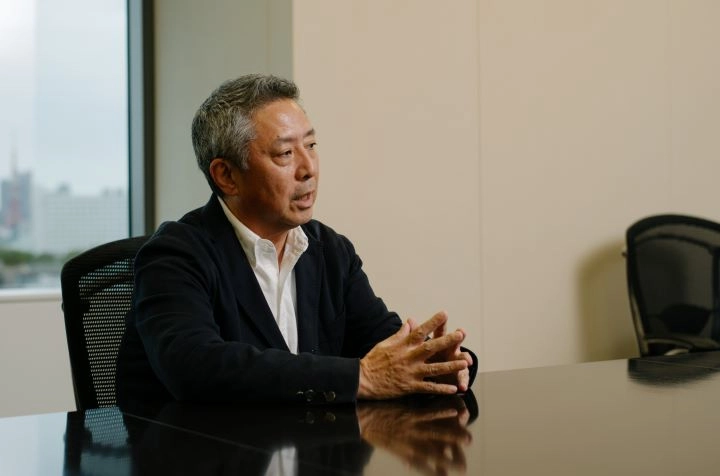
Changing the awareness of both companies and individuals
What are your current challenges, and what solutions are you pursuing?
At the moment, we are tackling two major challenges.
One is to develop a scheme for integrating social and economic value.
There are still not many precedents when it comes to social value projects like ours. No one knows how long it will take to recoup the funds invested or to what extent profits will increase, but companies tend to decide whether to participate in a project based on return on investment criteria, such as moving into the black within three years or eliminating cumulative losses in five to seven years. Our sense is that there are still few players in Japan that are serious about resolving social issues from a long-term perspective.
To address this situation, JRI has begun working to acquire B Corp Certification. A system set up by a US not-for-profit organization to certify companies engaging in activities with high social or environmental value, the “B” stands for “benefit for all,” while “Corp” is short for “corporation.” Of the 8,500-plus companies around the world that have acquired B Corp Certification, as at April 2024, only 40 were in Japan. The establishment in March 2024 of B Market Builder Japan—an organization designed to promote the B Corp movement here in Japan—should change that situation going forward, and JRI is also engaged in training human resources for the B Corp space as a BMBJ partner.
To get certified, companies have to balance profits with purpose. They have to provide value to society by addressing their impact on employees, the community, and customers, starting with reviewing their supply chains. We think that a lot of Japanese companies are probably leaving certification on the back burner because of how difficult the process is, but the hope is that JRI stepping up to the challenge will encourage those companies to follow suit.
Our second challenge is to raise the awareness of society as a whole.
It’s not just companies that are lacking agency when it comes to tackling social problems. Many individuals too are turning their backs even on action that is absolutely essential for the next generation.
In 2022, JRI and Musashino Art University set up the Convivial Design Studio to work with students and lecturers on community design. Adopting design thinking has enabled us to convey difficult concepts far more effectively than if we attempted to explain them in words, while actually moving into communities and engaging in ongoing dialogue with local residents is also beginning to produce clear signs of change in the way that residents think and act.
We plan to continue working on this project while also expanding the schemes we have developed out on to a nationwide basis and changing awareness from the ground up.
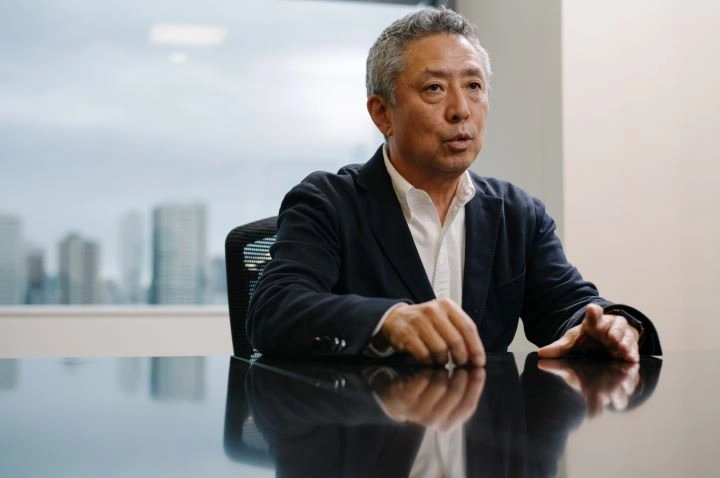
-
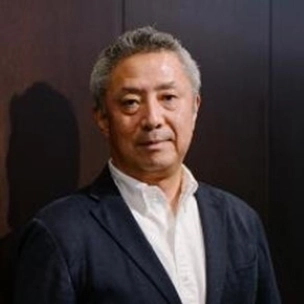
Senior Managing Director, Japan Research Institute
Teruhiko Kinoshita
Born in Ehime Prefecture. Graduated from the Kobe University Graduate School of Business Administration with a Master of Commerce. He worked at the Sumitomo Mitsui Banking Corporation before joining JRI. After a stint in academia specializing in marketing, he returned to JRI, primarily handling consulting on strategy for the healthcare industry. Currently heads the JRI Research & Consulting Division. Visiting professor at the Globis University Graduate School of Management and a part-time lecturer at the Otaru University of Commerce.

